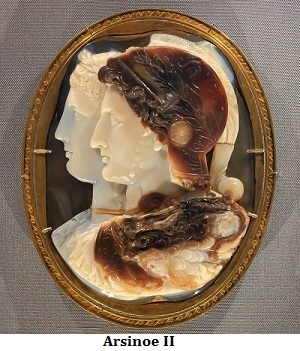

 Pharaoh Ptolemy, I Soter developed the Hellenistic Republic of Egypt. His second bride Berenice I of Egypt had a daughter named Arsinoe. She played a significant role in ritual and public layout together with her brother, worked as a spiritual and expressive patron, and attended the Egyptian and Greek religions that her brother had constructed for them.
Pharaoh Ptolemy, I Soter developed the Hellenistic Republic of Egypt. His second bride Berenice I of Egypt had a daughter named Arsinoe. She played a significant role in ritual and public layout together with her brother, worked as a spiritual and expressive patron, and attended the Egyptian and Greek religions that her brother had constructed for them.
Her purpose as empress was astounding in the monarchy at the period and acted as a guide for later Ptolemaic mistresses.
She may have been born in Memphis, but Alexandria, a new city, was where she had been developed. She earned approximately a college learning. Furthermore, she imparted with Strato of Lampsacus, who was possibly her educator in the past. Agathocles, the very first heir of Lysimachus, was sickened for traitors to place her sons in line to inherit the throne.
Mostly in Samothrace palace, where Arsinoe admittedly compensated for a foyer, she was potentially introductory. Then she wed Ptolemy Keraunos. Both entities in the marriage claimed the monarchy of Thrace and Macedonia for business reasons. Throughout the Samothrace sanctuary, from which Arsinoe had emerged as empress, she found refuge. To seek survival from Ptolemy II Philadelphus, she finally departed from Samothrace for Alexandria, Egypt. She performed duties in ritual and media signage together with her brother, was placed as a heavenly and literal guest, and engaged in the Egyptian and Greek religions that her brother had defined for them. Her influence as empress was remarkable for the lineage of the period and acted as a mentor for later Ptolemaic queens.
Posidippus alleged that she finished in three gladiatorial contests at the Olympics, presumably in 272 BC.
Arsinoe is demonstrated among many of the gods being provided real sacrifice by Ptolemy through the solace at the front of the stele-a picture that has been located everywhere across Egypt. Arsinoe obtained distinct temples that were developed in Memphis and several other locations. With Arsinoe working like its patron goddess, the Fayyum country remained identified as the Arsinoite nome. At Mendes, which she represented as a priestess, she was provided burial and deification protocols. The Mendes stele recollects these rituals. This tomb also possesses Ptolemy II's statement of her worship. Alexandria also fostered the religion of Arsinoe. By 269 BC, a yearly priesthood called the Canephorus of Arsinoe Philadelphus had been constituted.
Until the end of the second century BC, the office holder was a factor in the dating process for certain government documents. In Alexandria, a huge temple had been constructed along the harbour. Near Cape Zephyrium, at the eastern extremity of the estuary, in which Arsinoe was honoured as Aphrodite Euploia, the general Callicrates of Samos founded another temple. Safeguarding against tragedies evolved to be closely identified with Arsinoe. The deity Arsinoe is still displayed on coins and replicas. Across the Ptolemaic epoch, Arsinoe claims to have retained a significant reputation among Greeks and Egyptians in Egypt and elsewhere. One of the many Greek identities that have been acquired like an Egyptian formal title during a certain time was “Arsinoe.” Hundreds of her enamelled have been excavated in the Alexandrian catacombs, along with chapels and dedicatory monuments in her memory, that can be viewed everywhere across Egypt and the Aegean.
She has two cornucopias that she possesses, in addition to a miniature ram's horn underneath her ear that exemplifies her partnership with the ram of Mendes.
Arsinoe wed Lysimachus of Thrace, and the couple had 3 children. Well after the burial of Lysimachus around 281 BC, Arsinoe cursorily wed her half-brother Ptolemy Ceraunus during 280 to 279 BC, and to then her younger brother Ptolemy II of Egypt from the end of 270s BC till the demise. In the late 260s BC, Ptolemy II's children from his previous spouse to Arsinoe I, especially his inevitable rightful heir Ptolemy III, were legally recognized as being the descendent of Arsinoe II.
Arsinoe II, empress of Thrace and Egypt, was born around 316 BC. She decided to marry the lord of Thrace and pushed to get her kid named heir than just Agathocles, the monarch's son from an earlier husband. She was the daughter of Ptolemy I Soter. Agathocles asked the Seleucids for relief, commencing a dispute in which Arsinoe's spouse was killed during the battle. She was compelled into wedding her half-brother, who gained prominence in Thrace and Macedonia, after which he butchered her two younger boys. The two had been recognized as "Philadelphoi", because she moved to Alexandria, dismissed her brother Ptolemy II's wife, and wed him. She exchanged countless awards with Ptolemy and commanded enormous power, such as being canonised while still living.
Q1. Was always Ptolemy II and Arsinoe II's relationship dubious?
Ans. The relationship between Arsinoe II and her half-brother was not idyllic. Ptolemy Keraunos' political structure would be elevated by his wedding to Arsinoe II. Arsinoe II organised with her sons to execute Ptolemy's stepfather when he was out on a mission considering that he was proving too strong.
Q2. Who discredited the Ptolemaic principle?
Ans. Ptolemy's arguments all endeavoured to establish the earth's placement as the universe's centre of mass. Copernicus had proved false Ptolemy by 1543.
Q3. Where did Arsinoe get brutally murdered?
Ans. Arsinoe was strangled on the Monastery of Artemis' pillars, and her blood damaged one of antiquity's treasures.